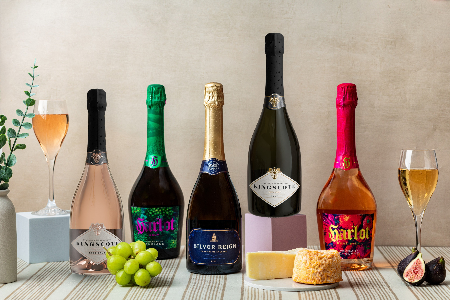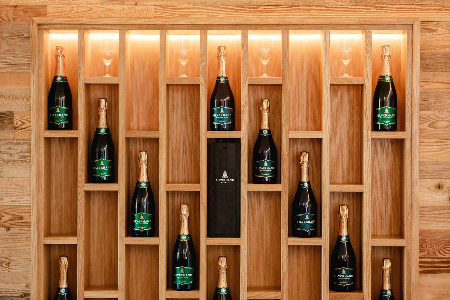What is English Sparkling Wine?
Without a doubt, English sparkling wine is one of the fastest growing wines in the world right now, for popularity.
Just for anyone that may be confused, English sparkling wine is a type of sparkling wine that is produced in the United Kingdom.
Its tiny bubbles, authentic taste and the typical winemaking process used to produce it, make it unique and famous all over the world.
In its simplest form a sparkling wine is a wine that has been fermented in a bottle to produce carbon dioxide bubbles.
The wine becomes fizzy and has a light, sparkling character due to the presence of these bubbles.
Sparkling wines are typically white wines with added sugar and flavourings, giving them a uniquely sweet and pleasant taste which has aided in it’s rapid growing popularity.
A recent Statista report suggests that sparkling wine will account for a whopping $44.21 billion in global revenue by the end of 2022.
The market is also predicted to expand thereafter by around 8.5% every year. According to Wikipedia, 68% of all wine made in the United Kingdom in 2017 was English sparkling wine, making this one of our most popular exports.
In fact the number of wineries in England dedicated to the production of sparkling wines now exceeds 100 (note: we found this both shocking and delicious in equal measure).
The South East of England plays host to the bulk of England's sparkling wine production, with more than 75% of the country's vineyards planted in this area.

So how is English sparkling wine made?
So if you’re wondering exactly how this wonderful wine is produced, it’s time to grab your notepad and pen as we’re going to look now at the process.
Firstly it’s worth noting that English sparkling wine is often considered a little more expensive than a lot of other international sparkling wines, largely due to the winemaking process and also because it generally comes from smaller vineyards.
Now, if you’re guilty of already being quite au fait with a variety of sparkling wines (don’t worry you’re certainly in good company here), you've probably heard the names “Classic Cuvée,” “Blanc de Blancs,” and “Demi-Sec” splashed around, all of which are terms used by English sparkling winemakers to describe their particular wine types.
There are six main methods used globally to make sparkling wine: the Traditional method; the Ancestral method; the Transfer method; the Dioise method; the Charmat method; and finally the continuous method.
However, only the Traditional method is used to make English sparkling wine and many experts believe this plays a large part in the final taste of the produce.
Let's take a look below at how the Traditional method is used specifically to make English sparkling wine:
Step 1
First of all, a base wine must be made. An entier hand-picked bunch of pressed grapes are used to make the base wine and each variety and copy is normally fermented individually.
They're refined, clarified, and stabilized afterwards. Normally, primary or ‘first’ fermentation takes place in tanks or barrels.
The grape varieties Chardonnay, Pinot noir, and Pinot Meunier are often used to produce English sparkling wine, and these grapes are mostly farmed in the south and southeastern regions of the United Kingdom.
Step 2
The second step is deciding which wines to combine and blend from which tanks and barrels, to produce the various wine types.
The selected mix, or cuvée, is then bottled, with a little yeast and sugar added to allow for the secondary fermentation.
Secondary fermentation must take place in the bottle itself. The CO2 (Carbon Dioxide) is trapped within the bottle, which causes the wine to bubble.
Step 3
This step entails waiting for the Autolysis process to complete. For a period of years, the winemakers keep the bottle in a well-controlled and ideal environment.
During this time, the yeast breaks down due to self-produced enzymes, creating that famous flavour and taste that we have come to recognise.
Step 4
This procedure includes ‘riddling’ the bottle to remove the yeast. The wines are disgorged after a few days by freezing the bottleneck.
The pressure within the bottle drives the frozen yeast plug out when the crown cap is removed.
The winemaker then adds dosage (a type of sugar) and then closes the bottle with a cork.
Step 5
This is the last part of the process, which involves packing and labelling. To let the wines acclimatize to being under cork and integrate, many winemakers keep them for at least 2-4 months after disgorgement.
The wines are then ready to be sold and consumed.
Other alternatives to English sparkling wine
There are some well-known sparkling wines, beyond the English sparkling wine we’re here to discuss, that make for some great alternatives.
Let's have a look now, in a little better detail, at those alternatives and see which other varieties are available to consumers around the world.
Champagne
Arguably the most well known, by name, Champagne hails from the very same French region from which it takes its name.
The production process of Champagne is quite similar to that of English sparkling wine. The Traditional method is also known as “méthode champenoise” and is largely followed to produce a variety of popular Champagnes.
After the 2nd fermentation stage, both wines need strong acid-base wines that retain their acidity.
Though English sparkling wine is slightly distinct from Champagne in terms of its grapes, vineyards, production process, and taste… Champagne varieties generally taste drier than the English sparkling wine.
Cremant
Another largely popular sparkling wine from France, Cremant is very much in a different category to Champagne.
Due to its "creamy" behaviour, it was given this name as the decreased carbon dioxide pressure gives these wines a creamy rather than fizzy texture.
Although also produced using the Traditional Method, these wines are considered to carry a creamy, nutty taste, rather than the sweeter taste of many of its ‘cousins’ .
Prosecco
Now THIS is a popular choice. A firm favourite is this beautiful variety of sparkling wine from Italy, whose name is derived from an Italian village of the same name (where this particular variety originated).
Unlike the other sparkling wines we’ve discussed so far, the Charmat method is used to make this wine.
As a result, it is both cheaper and faster to produce than English sparkling wine and subsequently is more readily available at a wider range of stockists across the UK and EU.
Made mostly from the Glera grape variety, Prosecco bubbles are said to be larger than that of the likes of Champagne or English Sparkling wines and therefore feel ‘fizzier’ in texture.
Cava
Cava is a sparkling wine produced in Spain, mostly in the Catalonian region. Whilst it can be largely compared to Prosecco, The Traditional method is actually used to make this type of wine.
Its grape varieties are distinct from the others, which typically mean Cava has a lemony flavour and is less sweet than Prosecco.
Cava is mostly made from Mcabeu (a Spanish grape). The grape varietals Parellada, Xarello, and Chardonnay are also utilised in some cases.
Sket
This is a German sparkling wine and, like Prosecco, it too is usually made using the Charmat process.
A safety cage (muselet) is usually included with Sekt to keep the cork in place despite the high CO2 pressure.
In comparison to other sparkling wines, Sket has a modest percentage of sweetness and alcohol and is often enjoyed with meat dishes.
Whilst these represent some of the most popular varieties, globally, there are also many other popular sparkling wines from around the world.
Pezsgo (Hungarian sparkling wine), Sovetskoye Shampanskoye (Russian sparkling wine), American sparkling wine, Romanian sparkling wine, Ukrainian sparkling wine, Chilean sparkling wine, South African sparkling wine, Canadian sparkling wine, and Australian sparkling wine are among those considered most popular dependant on which continent you find yourself drinking.

How to store English sparkling wine
Most people overlook the significance of correctly preserving English sparkling wine (and indeed wine as a whole), however this can often have an impact on the flavour of your wine - so we thought we’d look out for the people and give you our top tips for storing English sparkling wine.
When you open a bottle of English sparkling wine, the cork stopper will keep the wine fresh for roughly about 3 days.
For long-term storage, place the bottles on their sides in a cold, stable environment, such as a cellar or a colder/darker space (indoors).
For short-term storage, store the wine bottles upright in the bottom of the refrigerator until you're ready to enjoy.
Sparkling wine should be kept straight where possible to prevent the cork from becoming too damp and allowing oxygen to enter, causing the wine to become overly bubbly and spoiled.
It's best advised, to preserve these wines to their optimum flavour and texture, to keep them in a dark, temperature-controlled environment that's no more than 55 degrees.
Summary
So to re-cap… Whilst English sparkling wine may not be as well known globally as its French & Italian counterparts, it is fast becoming a large part of western culture and indeed some non-western cultures as well.
Many people actually prefer English Sparkling wine to many other similar types of wine due to its taste and this is largely credited to the process undertaken.
It is a well known fact that Hampshire’s Hambleton Vineyard was the “birthplace” of what we now call “English Sparkling wine” and many producers in England now choose to produce both Vintage and non-vintage bottles of English Sparkling Wine to offer a fine variety to their clientele.
With the rise in demand for English Sparkling Wine (due to the likes of local supermarkets, restaurants and the home consumer) it is incredibly likely that the taste of English Sparkling Wine will only continue to improve with time and demand.
At The Wine Caverns we pride ourselves immensely on bringing some of the finest bottles of English sparkling wine, straight to your door.
The Wine Caverns is a reputable e-commerce site that specialises in different types of wine. Exclusive sparkling wines with discounts and free delivery are available here.


















